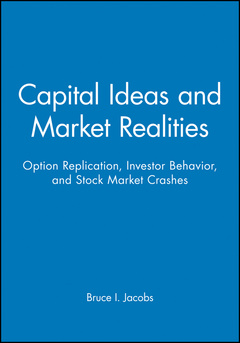Description
Capital Ideas and Market Realities
Option Replication, Investor Behavior, and Stock Market Crashes
Author: Jacobs Bruce I.
Language: English
Subject for Capital Ideas and Market Realities:
424 p. · 15.4x22.8 cm · Paperback
Description
/li>Contents
/li>Biography
/li>
Bruce Jacobs sifts through the history of modern finance, from the efficient market hypothesis to behavioral psychology and chaos theory, to determine the cause of recent market crashes.
- Includes a Foreword from Nobel Laureate Harry M. Markowitz.
- Showcases the expertise of an author who identified and predicted the causes of 1987, 1997 and 1998 crashes.
- Explains the risks of little-understood option replication.
- Offers chapter summaries, appendices and a glossary.
Introduction.
Part I: From Ideas into Products: .
1. Options and Option Replication. Options. How Options Took Off. Replicating Options. Real vs. Synthetic Options. A Risk Posed.
Summary.
2. Synthetic Portfolio Insurance: The Sell. Asset Protection. Enhanced Returns. Unleashing the Aggressive Investor. Locking in Gains. Pension Fund Benefits. Beyond Equity. Job Security. "No Unhappy Surprises".
Summary.
3. A Free Lunch? Sacrificing Wealth. Implementation Pitfalls.
i. Falling Through the Floor.
ii. Missing the Upside.
iii. Unexpected Transaction Costs. Job Insecurity.
Summary.
4. Who Needs It? An Alternative: Buy Low and Sell High. Strategies in Practice. New and Improved.
Summary.
Part II: The Crash of 1987: A Reality Check:.
5. The Fall of a Reigning Paradigm. An Efficient Crash. The Fundamental Things. The Psychic Crash.
Summary.
6. Animal Spirits. Patterns. Noise. Overoptimism. Feedback Trading.
Summary.
7. Bubbles, Cascades and Chaos. Bubbles. Informational Cascades. Chaos.
Summary.
8. Futures and Index Arbitrage. The Futures - Stock Interface. The Mixed Evidence. Arbitrage and the Crash. A Massive Liquidity Event.
Summary.
Part III: How Dynamic Hedging Moved Markets: .
9. Synthetic Puts and the 1987 Crash: Theory. A Fad. An Informational Cascade. Insurance, Arbitrage and Liquidity.
Summary.
10. Synthetic Puts and the 1987 Crash: Evidence. Before the Crash. Black Monday. Roller Coaster Tuesday. Brady Commission and SEC Views.
Summary.
11. Alibis I: The U. S. Crash. No Bounce Back. Insurers Far from Only Sellers. Investors Would Have Sold Anyway. Insurance Sales Insufficient. Insurance Trades not Correlated with Market Moves.
Summary.
12. Alibis II: Across Time and Space. Explaining the 1929 Crash.
i. Margins Calls in 1929. Stocks Not in the S&P 500 Crashed. Explaining the International Crash. ii. The Synchronization of World Markets.
iii. Contagion Effects.
Summary.
13. Did Insurance Live up to Its Name? Crash Conditions. Whipsaws. A Retreat. Why It Failed.
Summary.
Part IV: Option Replication Resurrected:.
14. i. Mini-Crashes of 1989, 1991 and 1997, Friday the 13th, October 1989.
ii. Effect of Circuit Breakers.
iii. OTC Puts. November 15, 1991. Testing the Brakes: October 27, 1997.
Summary.
15. Sons of Portfolio Insurance. Sunshine Trading. Supershares. Options Reborn. Expanding the Listed Option Menu. Synthetic Warrants, Swaps and Guaranteed Equity.
i. Warrants.
ii. Swaps.
iii. Guaranteed Equity.
Summary.
16. The Enduring Risks of Synthetic Options Risks to Buyers. Risks to Dealers. Risks to Markets.
Summary.
17. Living with Investment Risk. Predicting Market Moves. A Long-Run Perspective. A Premium for Patience.
Summary.
18. Late Developments: Awful August 1998 and the long-term Capital Fallout. Behind the Price Moves. long-term Capital: A Hedge Fund in Need of a Hedge. A Frenzied Fall. Deja vu.
Summary. Epilogue.
Appendix A: The Continuing Debate.
Appendix B: Option Basics.
Appendix C: Option Replication.
Appendix D: Synthetic Options vs. Static-Allocation Portfolios.
Glossary.
Bibliography.
Index.
Bruce I. Jacobs is co-founder, co-chief investment officer, and co-director of research at Jacobs Levy Equity Management. He holds a Ph.D. in finance from the Wharton School of the University of Pennsylvania. For 35 years, he has been a major voice for financial transparency. Jacobs has written journal articles and books on equity management and financial crises, including Too Smart for Our Own Good: Ingenious Investment Strategies, Illusions of Safety, and Market Crashes (2018). He has spoken at prestigious forums, including those held by University of California, Berkeley, the Wharton School, Institute for Quantitative Research in Finance, CFA Institute, Society of Quantitative Analysts, and New York Society of Security Analysts.
These books may interest you

Investing for the Long Term 24.87 €



